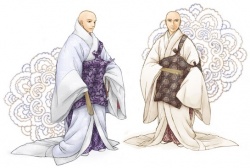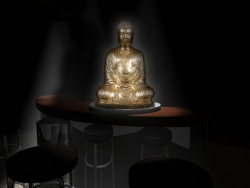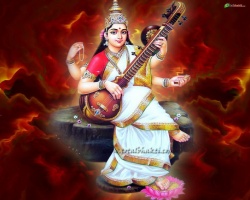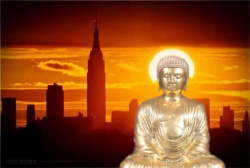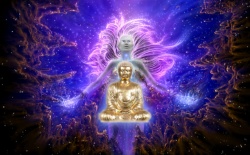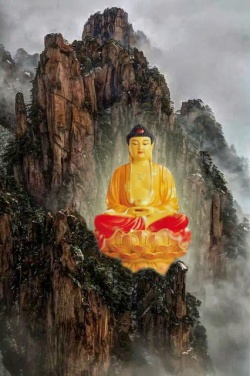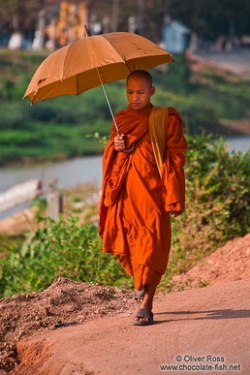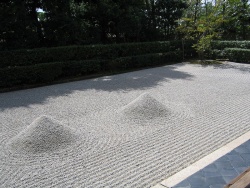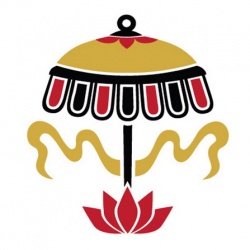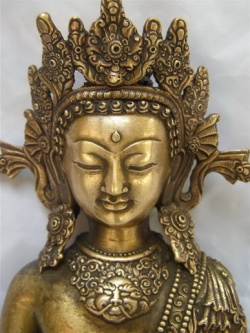Difference between revisions of "The Sera Monastery"
(Created page with "The Sera Monastery is the last of the three principal Yellow Sect monasteries built in Lhasa. The setting itself is very beautiful with cobbled alleyways,...") |
|||
| Line 1: | Line 1: | ||
| − | + | <nomobile>{{DisplayImages|2377|2094|3298|2057|3947|4206|1431|3620|3535|1141}}</nomobile> | |
| − | |||
| − | |||
| − | |||
| − | |||
| − | |||
| − | |||
| − | + | The [[Sera Monastery]] is the last of the three [[principal]] [[Yellow Sect]] [[monasteries]] built in [[Lhasa]]. | |
| − | On the second floor, there are three chapels: the [[Zhelre Lhakhang]] from where [[Maitreya]] could be seen embossed with a small [[Tsongkhapa]] on its [[heart]]; the [[Tu-je Chenpo Lhakhang]] that had an [[Avalokiteshvara]] with eleven faces (found at [[Pawangka]]), [[Tara]] and [[six–armed Mahakala]]. The [[idol]] of [[Shakyamuni Buddha]] which flanked by [[statues]] of [[Gelukpa]] [[Lamas]] were placed in the [[Shakyamuni Lhakhang]]. | + | The setting itself is very beautiful with cobbled alleyways, [[temples]] and {{Wiki|colleges}}. |
| + | |||
| + | The highlight of visiting [[Sera Monastery]] will be watching [[monks]] [[debating]] inside the shady courtyard behind the main [[temple]]. | ||
| + | |||
| + | Every day, hundreds of red-robed [[monks]] assemble in small groups and practice their [[debating]] skills. | ||
| + | |||
| + | Founded in 1419 by [[Sakya Yeshe]], a [[disciple of Tsong Khapa]], [[Sera Monastery]] is one of the great three [[Gelukpa]] {{Wiki|university}} [[monasteries]] of [[Tibet]]. | ||
| + | |||
| + | The original [[Sera Monastery]] was in [[Lhasa]], about 5 km [[north]] of the [[Jokhang Temple]] in [[Lhasa]]. | ||
| + | |||
| + | [[Sera Monastery]] once housed more than 5,000 [[monks]] in 1959. | ||
| + | |||
| + | Although badly damaged, it is still [[standing]] and has been largely repaired. | ||
| + | |||
| + | It now houses a few hundred [[Buddhist monks]]. | ||
| + | |||
| + | The highlight of visiting in [[Sera Monastery]] will be watching a [[monks]] [[debating]] inside the shady courtyard behind the main [[temple]]. | ||
| + | |||
| + | Every day, hundreds of red-robed [[monks]] assemble in small groups and practice their [[debating]] skills. | ||
| + | |||
| + | It is a highly entertaining spectacle, during which they strike poses not dissimilar to hip hop rappers. They are clap, turn, and finger point, whoop, holler, and throw their [[prayer beads]] about. | ||
| + | |||
| + | In most cases, one [[monk]] sits on the floor, while another one stands, and between them, they argue about [[Buddhist rituals]] - immensely enjoying their [[debates]]. | ||
| + | |||
| + | As tourists you are allowed to walk around the edge and observe the very dynamic and animated [[monks]] asking and answering questions like ‘why', ‘what came first the chicken or the egg' and ‘who is your favorite [[Buddha]]'. | ||
| + | |||
| + | The spectacle is just so fun-filled and high [[energy]]. It's a bit like a Sicilian market place, or a football match, increasing in volume all the time, and some of the [[monks]] are really good showmen, sometimes mischievously involving you in their [[debates]], as if trying to get you onto their side. | ||
| + | |||
| + | |||
| + | |||
| + | ==The [[Great Assembly Hall]] ([[措钦大殿]])== | ||
| + | |||
| + | |||
| + | |||
| + | The [[Great Assembly Hall]], the ‘[[Tsochin]]' or '[[Coqen Hall]]' is one of the largest palace of [[Sera Monastery]] and is the administration center of [[Sera Monastery]] [[religious]] affairs. | ||
| + | |||
| + | In 1710, {{Wiki|Gushri Khan}} descendant [[Wikipedia:Lha-bzang Khan|Lhazang Khan]] directly sponsored and built the hall. | ||
| + | |||
| + | It is a four-storey {{Wiki|structure}} to the [[north east]] of the [[monastery]], facing [[east]], is where several [[religious]] [[rituals]] and [[rites]] are conducted. | ||
| + | |||
| + | The hall covered an area of 2,000 square meters, built with 125 pillars (86 tall and 39 short columns). | ||
| + | |||
| + | The hall gate is facing due [[south]] and the entry portico had ten columns, painted with colored [[four heavenly kings]]. | ||
| + | |||
| + | The seventh [[dalai]] ([[Kelsang Gyatso]]) passed away and [[people]] made a statue of [[Jampa]] ([[byams-pa]]) of 5 meters high gilding bronze statue in the [[east]], | ||
| + | |||
| + | besides there are [[Tsongkhapa]] with his three favorite [[disciples]] [[statues]], [[Dorje Langque]] and others [[gelug sect]] [[buddhist]] {{Wiki|eminent}} [[monks]] [[statues]] and a [[Buddha]] tower. | ||
| + | |||
| + | On the back there are three inner chapels, sequentially, are the [[Jampa Lhakhang]] in the middle, the [[Neten Lhakhang]] and [[Jigje Lhakhang]]. | ||
| + | |||
| + | A 6 meters (20 ft) high image of [[Maitreya]] was deified in [[Jampa Lhakhang]] ensconced by [[Eight Bodhisattvas]] (also known as "eight big [[Buddha disciples]]", | ||
| + | |||
| + | namely, [[Maitreya]], [[Manjusri bodhisattva]], [[Avalokitesvara bodhisattva]], [[Samantabhadra bodhisattva]], [[Mahasthamaprapta]], [[Akasagarbha]], [[Ksitigarbha]], and [[Sarvanivarana-Vishkambhin]]), the treasured [[Kagyur]] and guarded by [[Hayagriva]] and [[Acala]] at the entrance. | ||
| + | |||
| + | On the [[west]] side of the [[Jampa]] [[Buddha]] Hall is [[Arhat Hall]], [[consecrated]] [[Buddha sakyamuni]] inside the center, on both sides are [[sixteen arhats]] and four major [[Kings]] [[statues]], | ||
| + | |||
| + | which are clay {{Wiki|sculpture}} colored drawing. On the [[east]] side of [[Jampa Buddha Hall]] is [[Jigje Lhakhang]], [[Jigje Lhakhang]] houses the image of {{Wiki|Bhairava}} with his [[consort]] and [[Shridevi]] and other [[protector deities]]. | ||
| + | |||
| + | On the second floor, there are three chapels: the [[Zhelre Lhakhang]] from where [[Maitreya]] could be seen embossed with a small [[Tsongkhapa]] on its [[heart]]; the [[Tu-je Chenpo Lhakhang]] that had an [[Avalokiteshvara]] with eleven faces (found at [[Pawangka]]), | ||
| + | |||
| + | [[Tara]] and [[six–armed Mahakala]]. | ||
| + | |||
| + | The [[idol]] of [[Shakyamuni Buddha]] which flanked by [[statues]] of [[Gelukpa]] [[Lamas]] were placed in the [[Shakyamuni Lhakhang]]. | ||
The third and the fourth floors are used as private apartments for the [[Dalai Lamas]] and the preceptors of the Main Assembly Hall. | The third and the fourth floors are used as private apartments for the [[Dalai Lamas]] and the preceptors of the Main Assembly Hall. | ||
| − | |||
| − | |||
| − | |||
| − | + | ==[[Je Dratsang]] ([[吉扎仓]])== | |
| − | + | ||
| + | |||
| + | |||
| + | [[Je Dratsang]] is the largest [[dratsang]] in [[Sera Monastery]], covers an area of 1702 square meters, the area ranks second to [[Tsochin Hall]]. | ||
| + | |||
| + | Founded in 1435, the establisher was [[Jetsun Kunkhen Lodroe Rinchen Senge]]. [[Rinchen Senge]] was [[Tsang]] [[people]], he formally [[acknowledge]] [[Shekya Yeshe]] as his [[master]] when he was young, also learned [[Esoteric Buddhism]] from [[Tsongkhapa]], | ||
| + | |||
| + | and in accordance with the [[Tsongkhapa]] (forefather of the [[gelug sect]]) [[to build]] Je [[Dratsang]], and became the first [[Khenpo]] ([[abbot]]). | ||
| + | |||
| + | [[Je Dratsang]] was initially a three storied building; a fourth floor was added in the 18th century by strengthening the building with a total of 100 columns. | ||
| + | |||
| + | It had a statue of the [[Hayagriva]], also known popularly as [[Avalokiteśvara]], which was considered the [[protective deity]] of the [[monastery]]. | ||
| + | |||
| + | Inside [[scripture]] hall, there is [[thangka]], {{Wiki|canopy}}, [[religious]] curtain, and painted walls around drew [[Buddha]] {{Wiki|biography}} and various [[protective deities]]. | ||
| + | |||
| + | On the second floor of [[Je Dratsang]], there are two [[Buddha]] halls: | ||
| + | |||
| + | on the [[west]] is the [[Zelre Lhakhang]], provided an overview of the main [[Hayagriva]] image in the floor below, and also a small image of [[Nine-headed Hayagriva]] along with images of [[Padmasambhava]], the [[5th Dalai Lama]] and the [[protector deities]]; | ||
| + | |||
| + | on the [[east]] if the Hall of [[Avalokitesvara]] [[Boddhisatva]], [[consecrated]] [[Avalokitesvara]]. | ||
| + | |||
| + | On the third floor is the [[Namgyel Lhakhang]] and the forth floor above this is the living quarters when [[Dalai Lamas]] came here for {{Wiki|sermon}} and on the both sides are living quarters of [[Dratsang Khenpo]] ([[abbot]]) and other administrators. | ||
| + | |||
| + | |||
| + | |||
| + | ==[[Me Dratsang]] ([[麦扎仓]])== | ||
| + | |||
| + | |||
| + | |||
| + | [[Me Dratsang]] is the early construction of [[Sera Monastery]]. Founded in 1419, and it was built by [[Monastery]] founder [[Shekya Yeshe]]. | ||
| + | |||
| + | It is said to at the beginning of building palace, the [[Me Dratsang]] was destroyed by {{Wiki|lightning}} strikes, and in A.D. 1761 it was rebuilt by [[Kunkhen Jangchub Penpa]]. | ||
| + | |||
| + | It covers an area of 1620 square meters. | ||
| + | |||
| + | Inside there were 8 tall columns and 62 short columns which contained a {{Wiki|galaxy}} of [[statues]] of [[Buddhist]] [[gurus]] with the main [[deity]] of [[Shakyamuni Buddha]] made in {{Wiki|copper}}. | ||
| + | |||
| + | On the both sides of the main [[deity]] of [[Shakyamuni Buddha]] enshrined [[Maitreya]], [[Amatyas]], [[Bhavishyaguru]], [[Manjushri]], [[Tsongkhapa]] with his three [[disciples]], [[seventh Dalai Lama]], [[Pawanga Rinpoche]] and several other {{Wiki|past}} [[masters]] of the [[dratsang]]. | ||
| + | |||
| + | On the [[north]] side there are four chapels: the [[west]] is [[Dharmapala Chapel]] ([[Tawok Lhakhang]]), enshrined [[dharmapala Tawok]]. | ||
| + | |||
| + | And on the [[east]] of the [[Dharmapala]] chapel in proper order is: [[Arhat Hall]] ([[Neten Lhakahng]]) with images of [[Buddha]] of Three Times in the company of '[[Sixteen Elders]]' depicted in their mountain [[caves]], volumes of the [[sacred]] [[Prajnaparamita]] text, the [[Shakyamuni Hall]] ([[Jowokhang]]) with large [[Buddha]] image (replaced an earlier image of [[Miwang Jowo Shakyamuni]]) along with [[Eight Bodhisattvas]], and [[gatekeepers]] [[Hayagriva]] and [[Acala]] and [[Tsongkhapa]] Hall ([[Tsongkhapa Lhakhang]]). | ||
| + | |||
| + | The second floor of [[Me Dratsang]] had the [[Temple]] of {{Wiki|Sun}} (the [[Nyima Lhakhang]]) and [[Kangyur Sutra Hall]] ([[Kangyur Lhakhang]]). | ||
| + | |||
| + | In the [[Kangyur]] [[Lhakhang]], originally there were [[108]] delicately written [[scriptures]] ‘the [[Gangyur]] of [[Tripitaka]]’ and other classics by golden powder and they were lost during the {{Wiki|Cultural Revolution}}, and now there were 1000 images of [[Tara]] replaced in the [[Buddhist]] cabinet. | ||
| + | |||
| + | In the middle of the third floor was reserved for the [[Dalai Lamas]] bedroom, and the living quarter and office [[space]] for [[dratsang]] aside. | ||
| + | |||
| + | |||
| + | |||
| + | ==[[Ngakpa Dratsang]] ([[阿巴扎仓]])== | ||
| + | |||
| + | |||
| + | |||
| + | [[Ngakpa Dratsang]] is an early construction in [[Sera Monastery]] and also the [[dratsang of Sera Esoteric Buddhism]]. | ||
| + | |||
| + | In 1419 AD it was established by [[Shekya Yeshe]] which was the [[Tsochin Hall]] of [[Sera Monastery]] at that time, in 1710 AD after the finishing of [[Tsochin Hall]] (the [[Great Assembly Hall]]) now, it was turned into [[dratsang]]. | ||
| + | |||
| + | [[Ngakpa Dratsang]] covers an area of 1517 square meters. | ||
| + | |||
| + | It is a three-storey building, which is made up of 4 chapels. It has 4 long columns, 42 short columns. | ||
| + | |||
| + | The main image in the centre of the hall was of [[Jamchen Chojey]] (wearing a black hat), founder of the [[monastery]]. | ||
| + | |||
| + | Other images enshrined in the hall were of [[Maitreya]], [[Gyeltsen Zangpo]] (first [[religious teacher]] of [[Sera]]), [[Pawangka Rinpoche]], [[Tsongkhapa]] (with his [[principle]] [[disciples]]), [[Dalai Lama XIII]], [[Chokyi Gyeltsen]] and [[Lodro Rinchen]] (founder of [[Sera Je]]). | ||
| + | |||
| + | The second floor of [[Ngakpa Dratsang]] was [[vihara]] and Amitqbha hall, enshrined with the [[Amitabha]] golden statue, [[stupas]] of [[Gyeltsen Zangpo]] and [[Jetsun Chokyi Gyeltsen]]. And there was a tower built by [[Wikipedia:Lha-bzang Khan|Lhazang Khan]]. The third floor was the residence of the [[Dalai Lama]]. | ||
| + | |||
| + | |||
| + | ==History== | ||
| + | |||
| + | |||
| + | Before the [[Sera Monastery]] built, [[master]] [[Tsongkhapa]] expounded the texts of [[Buddhism]] in a small [[temple]] of [[Sera]] in the [[east]] hillside. | ||
| + | |||
| + | He [[vyakarana]] here will [[form]] a [[monastery]] carry forward [[thought]] of [[Madhyamika]] in [[Mahayana Buddhism]], so he ordered [[Shekya Yeshe]] [[to build]] [[monastery]] here. | ||
| + | |||
| + | [[Shekya Yeshe]] (1352-1435 AD) was one of the greatest [[disciples]] of [[Tsongkhapa]], was the important figure during the [[gelug sect]] period. | ||
| + | |||
| + | In 1409 AD, he replaced [[Tsongkhapa]], responded [[Ming]] [[emperor]] [[Yongle’s]] call to {{Wiki|Beijing}}, and in 1414 AD, he went to {{Wiki|Beijing}} for the second time. | ||
| + | |||
| + | The following year he was awarded as national [[Guoshi]] ([[state]] [[master]]), In AD 1434, [[Ming]] [[emperor]] [[Xuande]] awarded him as great [[Dharma]] ([[Jamchen Chojey]] in [[Tibet]]), since then [[people]] regarded him as [[Jamchen Chojey]]. | ||
| + | |||
| + | He was the first [[people]] who built the [[gelug sect]] [[monasteries]] in the mainland, the relationship with the [[gelug sect]] between {{Wiki|Ming dynasty}} government was starting from him. | ||
| + | |||
| + | In 1419 AD, [[Jamchen Chojey]] [[constructed]] [[Sera Monastery]] under support of [[Neiwuzong]] (now Liuwu district, the [[western]] suburb of [[Lhasa]]) leader [[Nangka Sambu]]. | ||
| + | |||
| + | Then the [[monastery]] gradually formed 3 [[dratsangs]] and 32 [[khangtsens]]. | ||
| + | |||
| + | [[Sera Monastery]] covers an area of 114964 square meters, the original [[monks]] for 5500 [[people]], the actual reached 9000 [[people]]. | ||
| + | |||
| + | Main constructions are the [[Great Assembly]] Hall,Je [[Dratsang]], Me [[Dratsang]], [[Ngakpa Dratsang]] and [[khangtsens]]. | ||
| + | |||
| + | Early [[architecture]] is used Me [[Dratsang]] and [[Ngakpa Dratsang]] as the center, after the generation expansion, it enlarged to the size of the [[existing]]. | ||
| + | |||
| + | [[Sera Monastery]] demonstrates the features of the [[gelug sect]] great [[temple]] style. | ||
| + | |||
| + | After 47 years of [[Sera Monastery]] establishment, there are four [[dratsangs]], each [[dratsang]] has a {{Wiki|mentor}}, obtains the very big [[development]]. | ||
| + | |||
| + | Since the Third Plenary Session of the 11th Central Committee of the {{Wiki|Chinese Communist Party}} has opened, {{Wiki|Chinese}} national and [[religious]] policy was being implemented, and [[temples]] managed by different sects were repaired or rebuilt, and [[Sera]] [[mahayana]] [[temple]] restoration and new work also have progress for years. | ||
| + | |||
| + | Elderly [[monks]] [[life]] have safeguard, and will be carefree, their [[desires]] of practicing are met; Young [[monks]] according to their [[own]] will, also got good opportunity to learn {{Wiki|culture}}, to read and write. | ||
| + | |||
| + | |||
| + | ==Legend== | ||
| + | |||
| + | |||
| + | There are two arguments about the source of the [[name]] [[Sera Monastery]]: the first is that when laid a foundation of [[monastery]] there came a fiercely hailstone, hailstone in the [[Tibetan language]] pronounce as a "[[sera]]", so after the completion of [[monastery]] it named "[[Sera]]", meaning "hail [[monastery]]"; | ||
| + | |||
| + | Second is that the [[monastery]] built in the middle a blooming multiflora, hence the [[name]] "[[Sera monastery]]," the multiflora in the [[Tibetan language]] also pronounce "[[sera]]". | ||
| + | |||
| + | The full [[name]] is [[Sera Mahayana Monastery]]. | ||
| + | |||
| + | |||
| + | ==[[Sera Bengqin Festival]]== | ||
| + | |||
| + | |||
| + | In [[Sera Monastery]] there is a large and impressive {{Wiki|festival}} called “[[Sera Bengqin Festival]]”, which is the particular {{Wiki|festival}} of [[Vajra]] [[adhisthana]] of [[Sera Monastery]], largely attended by [[monks]] and {{Wiki|devotees}}. | ||
| + | |||
| + | It is said that in the late 15 century AD, a [[Vajra]] came from [[India]], [[people]] called it flying [[Vajra]], and later ppNagaba Dratsang Khenpo]] enshrined it in [[Tenzin Dharma Temple]]. | ||
| + | |||
| + | In the {{Wiki|past}}, the executive of [[Nagaba Dratsang]] rode a post-horse and ceremoniously took it to the [[Potala Palace]] to {{Wiki|present}} [[Dalai Lama]]. | ||
| + | |||
| + | [[The Dalai Lama]] offers [[prayers]] to the [[Buddha]] to bestow strength and blesses the [[Vajra]], and then the [[Vajra]] would be transferred back to [[Sera Monastery]]. | ||
| + | |||
| + | Thereafter, the pestle is briefly placed on the heads of the [[monks]] and [[disciples]] by the [[Ngaba Dratsang Khenpo]], So blessed with inspiration. | ||
| + | |||
| + | The {{Wiki|festival}} is held some time in February as per the {{Wiki|Gregorian calendar}} [[corresponding]] to specific date fixed by the [[monastery]] according to the [[Tibetan calendar]]. | ||
| + | |||
| + | |||
| + | ==[[Shoton Festival]]== | ||
| + | |||
| − | + | Another popular {{Wiki|festival}} witnessed by visitors and locals is the [[Shoton Festival]] held in the month of August in the [[Tibetan calendar]]. | |
| − | The | + | The {{Wiki|festival}} represents the [[symbolic]] Buddha-Unfolding, where {{Wiki|worship}} of the [[Buddha]] is the [[essential]] part. |
| − | + | And every {{Wiki|festival}}, there will host [[Sun Buddha]] {{Wiki|ceremony}}. | |
| − | |||
| − | |||
| − | + | ==Highlight== | |
| − | |||
| − | |||
| − | + | [[Debates]] among [[monks]] on the [[Buddhist doctrines]] are the [[discussion]] of [[Buddhism]] [[knowledge]], or another {{Wiki|learning}} process by [[Lama]]. | |
| − | + | Everyday, there will host a [[debate]] by [[monks]]. | |
| − | |||
| − | + | This facilitates better [[comprehension]] of the [[Buddhist philosophy]] to attain higher levels of study. | |
| − | |||
| − | [[ | ||
| − | |||
| − | + | This exemplary [[debating]] [[tradition]] supplemented with gestures is said to be exclusive to this [[monastery]]. | |
| − | |||
| − | + | As one of three major [[monasteries]] in [[Lhasa]], [[Sera Monastery]] may not as magnificent and grand as [[Drepung Monastery]], but the [[debates]] here are absolutely [[characteristic]]. | |
| − | + | {{R}} | |
| + | http://www.topchinatravel.com/china-attractions/sera-monastery.htm | ||
| + | [[Category:Sera Monastery]] | ||
Latest revision as of 08:05, 22 February 2016
The Sera Monastery is the last of the three principal Yellow Sect monasteries built in Lhasa.
The setting itself is very beautiful with cobbled alleyways, temples and colleges.
The highlight of visiting Sera Monastery will be watching monks debating inside the shady courtyard behind the main temple.
Every day, hundreds of red-robed monks assemble in small groups and practice their debating skills.
Founded in 1419 by Sakya Yeshe, a disciple of Tsong Khapa, Sera Monastery is one of the great three Gelukpa university monasteries of Tibet.
The original Sera Monastery was in Lhasa, about 5 km north of the Jokhang Temple in Lhasa.
Sera Monastery once housed more than 5,000 monks in 1959.
Although badly damaged, it is still standing and has been largely repaired.
It now houses a few hundred Buddhist monks.
The highlight of visiting in Sera Monastery will be watching a monks debating inside the shady courtyard behind the main temple.
Every day, hundreds of red-robed monks assemble in small groups and practice their debating skills.
It is a highly entertaining spectacle, during which they strike poses not dissimilar to hip hop rappers. They are clap, turn, and finger point, whoop, holler, and throw their prayer beads about.
In most cases, one monk sits on the floor, while another one stands, and between them, they argue about Buddhist rituals - immensely enjoying their debates.
As tourists you are allowed to walk around the edge and observe the very dynamic and animated monks asking and answering questions like ‘why', ‘what came first the chicken or the egg' and ‘who is your favorite Buddha'.
The spectacle is just so fun-filled and high energy. It's a bit like a Sicilian market place, or a football match, increasing in volume all the time, and some of the monks are really good showmen, sometimes mischievously involving you in their debates, as if trying to get you onto their side.
The Great Assembly Hall (措钦大殿)
The Great Assembly Hall, the ‘Tsochin' or 'Coqen Hall' is one of the largest palace of Sera Monastery and is the administration center of Sera Monastery religious affairs.
In 1710, Gushri Khan descendant Lhazang Khan directly sponsored and built the hall.
It is a four-storey structure to the north east of the monastery, facing east, is where several religious rituals and rites are conducted.
The hall covered an area of 2,000 square meters, built with 125 pillars (86 tall and 39 short columns).
The hall gate is facing due south and the entry portico had ten columns, painted with colored four heavenly kings.
The seventh dalai (Kelsang Gyatso) passed away and people made a statue of Jampa (byams-pa) of 5 meters high gilding bronze statue in the east,
besides there are Tsongkhapa with his three favorite disciples statues, Dorje Langque and others gelug sect buddhist eminent monks statues and a Buddha tower.
On the back there are three inner chapels, sequentially, are the Jampa Lhakhang in the middle, the Neten Lhakhang and Jigje Lhakhang.
A 6 meters (20 ft) high image of Maitreya was deified in Jampa Lhakhang ensconced by Eight Bodhisattvas (also known as "eight big Buddha disciples",
namely, Maitreya, Manjusri bodhisattva, Avalokitesvara bodhisattva, Samantabhadra bodhisattva, Mahasthamaprapta, Akasagarbha, Ksitigarbha, and Sarvanivarana-Vishkambhin), the treasured Kagyur and guarded by Hayagriva and Acala at the entrance.
On the west side of the Jampa Buddha Hall is Arhat Hall, consecrated Buddha sakyamuni inside the center, on both sides are sixteen arhats and four major Kings statues,
which are clay sculpture colored drawing. On the east side of Jampa Buddha Hall is Jigje Lhakhang, Jigje Lhakhang houses the image of Bhairava with his consort and Shridevi and other protector deities.
On the second floor, there are three chapels: the Zhelre Lhakhang from where Maitreya could be seen embossed with a small Tsongkhapa on its heart; the Tu-je Chenpo Lhakhang that had an Avalokiteshvara with eleven faces (found at Pawangka),
Tara and six–armed Mahakala.
The idol of Shakyamuni Buddha which flanked by statues of Gelukpa Lamas were placed in the Shakyamuni Lhakhang.
The third and the fourth floors are used as private apartments for the Dalai Lamas and the preceptors of the Main Assembly Hall.
Je Dratsang (吉扎仓)
Je Dratsang is the largest dratsang in Sera Monastery, covers an area of 1702 square meters, the area ranks second to Tsochin Hall.
Founded in 1435, the establisher was Jetsun Kunkhen Lodroe Rinchen Senge. Rinchen Senge was Tsang people, he formally acknowledge Shekya Yeshe as his master when he was young, also learned Esoteric Buddhism from Tsongkhapa,
and in accordance with the Tsongkhapa (forefather of the gelug sect) to build Je Dratsang, and became the first Khenpo (abbot).
Je Dratsang was initially a three storied building; a fourth floor was added in the 18th century by strengthening the building with a total of 100 columns.
It had a statue of the Hayagriva, also known popularly as Avalokiteśvara, which was considered the protective deity of the monastery.
Inside scripture hall, there is thangka, canopy, religious curtain, and painted walls around drew Buddha biography and various protective deities.
On the second floor of Je Dratsang, there are two Buddha halls:
on the west is the Zelre Lhakhang, provided an overview of the main Hayagriva image in the floor below, and also a small image of Nine-headed Hayagriva along with images of Padmasambhava, the 5th Dalai Lama and the protector deities;
on the east if the Hall of Avalokitesvara Boddhisatva, consecrated Avalokitesvara.
On the third floor is the Namgyel Lhakhang and the forth floor above this is the living quarters when Dalai Lamas came here for sermon and on the both sides are living quarters of Dratsang Khenpo (abbot) and other administrators.
Me Dratsang (麦扎仓)
Me Dratsang is the early construction of Sera Monastery. Founded in 1419, and it was built by Monastery founder Shekya Yeshe.
It is said to at the beginning of building palace, the Me Dratsang was destroyed by lightning strikes, and in A.D. 1761 it was rebuilt by Kunkhen Jangchub Penpa.
It covers an area of 1620 square meters.
Inside there were 8 tall columns and 62 short columns which contained a galaxy of statues of Buddhist gurus with the main deity of Shakyamuni Buddha made in copper.
On the both sides of the main deity of Shakyamuni Buddha enshrined Maitreya, Amatyas, Bhavishyaguru, Manjushri, Tsongkhapa with his three disciples, seventh Dalai Lama, Pawanga Rinpoche and several other past masters of the dratsang.
On the north side there are four chapels: the west is Dharmapala Chapel (Tawok Lhakhang), enshrined dharmapala Tawok.
And on the east of the Dharmapala chapel in proper order is: Arhat Hall (Neten Lhakahng) with images of Buddha of Three Times in the company of 'Sixteen Elders' depicted in their mountain caves, volumes of the sacred Prajnaparamita text, the Shakyamuni Hall (Jowokhang) with large Buddha image (replaced an earlier image of Miwang Jowo Shakyamuni) along with Eight Bodhisattvas, and gatekeepers Hayagriva and Acala and Tsongkhapa Hall (Tsongkhapa Lhakhang).
The second floor of Me Dratsang had the Temple of Sun (the Nyima Lhakhang) and Kangyur Sutra Hall (Kangyur Lhakhang).
In the Kangyur Lhakhang, originally there were 108 delicately written scriptures ‘the Gangyur of Tripitaka’ and other classics by golden powder and they were lost during the Cultural Revolution, and now there were 1000 images of Tara replaced in the Buddhist cabinet.
In the middle of the third floor was reserved for the Dalai Lamas bedroom, and the living quarter and office space for dratsang aside.
Ngakpa Dratsang (阿巴扎仓)
Ngakpa Dratsang is an early construction in Sera Monastery and also the dratsang of Sera Esoteric Buddhism.
In 1419 AD it was established by Shekya Yeshe which was the Tsochin Hall of Sera Monastery at that time, in 1710 AD after the finishing of Tsochin Hall (the Great Assembly Hall) now, it was turned into dratsang.
Ngakpa Dratsang covers an area of 1517 square meters.
It is a three-storey building, which is made up of 4 chapels. It has 4 long columns, 42 short columns.
The main image in the centre of the hall was of Jamchen Chojey (wearing a black hat), founder of the monastery.
Other images enshrined in the hall were of Maitreya, Gyeltsen Zangpo (first religious teacher of Sera), Pawangka Rinpoche, Tsongkhapa (with his principle disciples), Dalai Lama XIII, Chokyi Gyeltsen and Lodro Rinchen (founder of Sera Je).
The second floor of Ngakpa Dratsang was vihara and Amitqbha hall, enshrined with the Amitabha golden statue, stupas of Gyeltsen Zangpo and Jetsun Chokyi Gyeltsen. And there was a tower built by Lhazang Khan. The third floor was the residence of the Dalai Lama.
History
Before the Sera Monastery built, master Tsongkhapa expounded the texts of Buddhism in a small temple of Sera in the east hillside.
He vyakarana here will form a monastery carry forward thought of Madhyamika in Mahayana Buddhism, so he ordered Shekya Yeshe to build monastery here.
Shekya Yeshe (1352-1435 AD) was one of the greatest disciples of Tsongkhapa, was the important figure during the gelug sect period.
In 1409 AD, he replaced Tsongkhapa, responded Ming emperor Yongle’s call to Beijing, and in 1414 AD, he went to Beijing for the second time.
The following year he was awarded as national Guoshi (state master), In AD 1434, Ming emperor Xuande awarded him as great Dharma (Jamchen Chojey in Tibet), since then people regarded him as Jamchen Chojey.
He was the first people who built the gelug sect monasteries in the mainland, the relationship with the gelug sect between Ming dynasty government was starting from him.
In 1419 AD, Jamchen Chojey constructed Sera Monastery under support of Neiwuzong (now Liuwu district, the western suburb of Lhasa) leader Nangka Sambu.
Then the monastery gradually formed 3 dratsangs and 32 khangtsens.
Sera Monastery covers an area of 114964 square meters, the original monks for 5500 people, the actual reached 9000 people.
Main constructions are the Great Assembly Hall,Je Dratsang, Me Dratsang, Ngakpa Dratsang and khangtsens.
Early architecture is used Me Dratsang and Ngakpa Dratsang as the center, after the generation expansion, it enlarged to the size of the existing.
Sera Monastery demonstrates the features of the gelug sect great temple style.
After 47 years of Sera Monastery establishment, there are four dratsangs, each dratsang has a mentor, obtains the very big development.
Since the Third Plenary Session of the 11th Central Committee of the Chinese Communist Party has opened, Chinese national and religious policy was being implemented, and temples managed by different sects were repaired or rebuilt, and Sera mahayana temple restoration and new work also have progress for years.
Elderly monks life have safeguard, and will be carefree, their desires of practicing are met; Young monks according to their own will, also got good opportunity to learn culture, to read and write.
Legend
There are two arguments about the source of the name Sera Monastery: the first is that when laid a foundation of monastery there came a fiercely hailstone, hailstone in the Tibetan language pronounce as a "sera", so after the completion of monastery it named "Sera", meaning "hail monastery";
Second is that the monastery built in the middle a blooming multiflora, hence the name "Sera monastery," the multiflora in the Tibetan language also pronounce "sera".
The full name is Sera Mahayana Monastery.
Sera Bengqin Festival
In Sera Monastery there is a large and impressive festival called “Sera Bengqin Festival”, which is the particular festival of Vajra adhisthana of Sera Monastery, largely attended by monks and devotees.
It is said that in the late 15 century AD, a Vajra came from India, people called it flying Vajra, and later ppNagaba Dratsang Khenpo]] enshrined it in Tenzin Dharma Temple.
In the past, the executive of Nagaba Dratsang rode a post-horse and ceremoniously took it to the Potala Palace to present Dalai Lama.
The Dalai Lama offers prayers to the Buddha to bestow strength and blesses the Vajra, and then the Vajra would be transferred back to Sera Monastery.
Thereafter, the pestle is briefly placed on the heads of the monks and disciples by the Ngaba Dratsang Khenpo, So blessed with inspiration.
The festival is held some time in February as per the Gregorian calendar corresponding to specific date fixed by the monastery according to the Tibetan calendar.
Shoton Festival
Another popular festival witnessed by visitors and locals is the Shoton Festival held in the month of August in the Tibetan calendar.
The festival represents the symbolic Buddha-Unfolding, where worship of the Buddha is the essential part.
And every festival, there will host Sun Buddha ceremony.
Highlight
Debates among monks on the Buddhist doctrines are the discussion of Buddhism knowledge, or another learning process by Lama.
Everyday, there will host a debate by monks.
This facilitates better comprehension of the Buddhist philosophy to attain higher levels of study.
This exemplary debating tradition supplemented with gestures is said to be exclusive to this monastery.
As one of three major monasteries in Lhasa, Sera Monastery may not as magnificent and grand as Drepung Monastery, but the debates here are absolutely characteristic.
Source
http://www.topchinatravel.com/china-attractions/sera-monastery.htm
